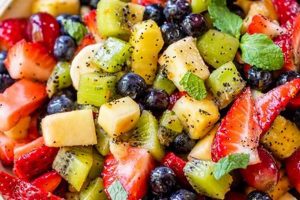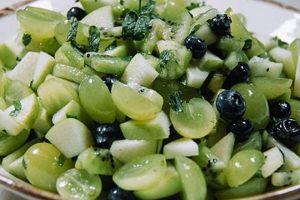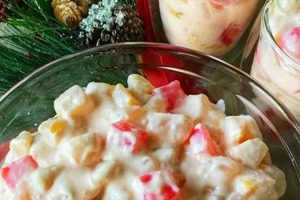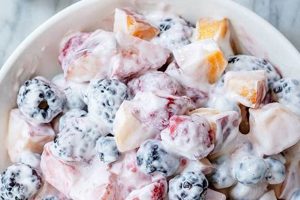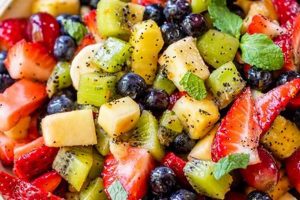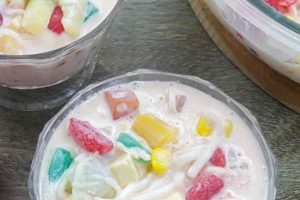A collection of fresh, bite-sized fruits combined creates a nutritious and appealing dish suitable for young palates. Such preparations often feature a mix of textures and flavors, incorporating sweeter fruits like berries and bananas with tart options such as oranges and kiwi. A simple example might include diced watermelon, grapes, strawberries, and cantaloupe, potentially tossed with a light dressing of fruit juice or yogurt.
These colorful medleys offer a significant nutritional boost, providing vitamins, minerals, and fiber essential for growing children. They serve as a healthy alternative to processed snacks and can foster an early appreciation for fresh produce. Historically, combining fruits in a single dish has been a practical way to utilize seasonal harvests and create refreshing treats, a tradition that continues to benefit children’s dietary health today.
This discussion will further explore creating appealing fruit salads for children, encompassing aspects like age-appropriate ingredients, safe preparation techniques, and creative presentation ideas to encourage consumption.
Tips for Creating Appealing Fruit Salads for Children
Careful consideration of ingredients, preparation methods, and presentation can significantly enhance the appeal of fruit salads for younger audiences. The following tips offer guidance on crafting nutritious and enticing fruit combinations.
Tip 1: Prioritize Soft, Bite-Sized Pieces. Cutting fruit into manageable pieces prevents choking hazards and makes consumption easier for smaller children. Grapes should be halved, and larger fruits like melons and mangoes should be diced into small cubes.
Tip 2: Embrace Variety. Incorporating a range of colors, textures, and flavors creates a more interesting and nutritionally balanced salad. Consider combining familiar favorites with less common fruits to expand palates.
Tip 3: Minimize Acidity. Highly acidic fruits like grapefruit and pineapple can be overwhelming for some children. Opt for milder options or use them sparingly, balancing their tartness with sweeter fruits.
Tip 4: Introduce Gentle Dressings. A light coating of fruit juice, yogurt, or a touch of honey can enhance flavor and prevent browning. Avoid heavy dressings or those high in added sugar.
Tip 5: Encourage Interaction. Presenting the fruit in an engaging manner can make the experience more enjoyable. Consider using cookie cutters to create fun shapes or arranging the salad in a visually appealing design.
Tip 6: Ensure Food Safety. Wash all fruits thoroughly before preparation. Refrigerate the salad promptly and discard any leftovers after two days to minimize the risk of bacterial growth.
Tip 7: Consider Seasonal Availability. Utilizing seasonal fruits offers peak flavor and nutritional value at a lower cost. Farmers’ markets can be a great source for fresh, locally grown produce.
By following these guidelines, one can create fruit salads that are not only nutritious but also visually appealing and enjoyable for children, fostering healthy eating habits from a young age.
These considerations collectively contribute to successful fruit salad preparation specifically tailored for children’s needs and preferences.
1. Kid-friendly Ingredients
Ingredient selection significantly impacts the success of fruit salads designed for children. “Kid-friendly” denotes ingredients palatable and appropriate for young consumers, emphasizing safety and enjoyment. This necessitates considering factors like texture, flavor profile, and potential allergens. Soft, easily chewed fruits such as bananas, berries, and melon chunks are preferred over harder options like apples or pears, which may pose choking hazards for toddlers. Similarly, milder flavors are generally favored; tart fruits like grapefruit might be overwhelming for some children. Prioritizing these aspects increases the likelihood of acceptance and encourages fruit consumption.
Consider the contrast between a fruit salad featuring grapes (halved to prevent choking), diced melon, and banana slices versus one containing whole grapes, starfruit, and pomegranate seeds. The former offers easily manageable pieces and familiar flavors, promoting positive eating experiences. The latter, while nutritious, presents potential choking hazards and introduces flavors children might find unfamiliar or unpleasant. This underscores the practical importance of selecting ingredients tailored to a child’s developmental stage and taste preferences. Furthermore, awareness of common fruit allergies, such as those to kiwi and strawberries, is crucial. Excluding known allergens or offering alternatives ensures inclusivity and safeguards children with dietary restrictions.
In essence, “kid-friendly ingredients” form the foundation of a successful fruit salad recipe for children. Thoughtful selection based on texture, flavor, and allergen considerations directly influences acceptance and enjoyment, promoting positive associations with healthy eating. This approach fosters both immediate consumption and long-term healthy dietary habits. Careful preparation further enhances these benefits, reinforcing the importance of adapting recipes to cater specifically to young consumers.
2. Safe Preparation
Safe preparation is paramount in a fruit salad recipe intended for children. This encompasses several crucial aspects, from proper hygiene practices to careful handling and cutting techniques. The objective is to minimize potential hazards and ensure the final product is safe for consumption by young children, a demographic particularly vulnerable to choking and foodborne illnesses. Neglecting these precautions can have significant consequences, ranging from mild discomfort to serious health issues.
Consider the act of washing fruit. Thorough washing under running water removes not only visible dirt and debris but also pesticide residues and microorganisms that could cause illness. Similarly, the method of cutting fruit directly impacts safety. Slicing grapes lengthwise prevents them from becoming lodged in a child’s airway, a significant choking hazard. Dicing larger fruits like melons and mangoes into small, manageable pieces further reduces this risk. These seemingly simple steps have profound implications for children’s well-being. A contaminated cantaloupe, improperly washed, could introduce harmful bacteria, leading to food poisoning. A whole grape, carelessly included in a salad, could obstruct a child’s breathing. These real-world examples underscore the critical role of safe preparation in preventing adverse outcomes.
Safe preparation practices are not merely a desirable addition to a fruit salad recipe for children; they are an indispensable component. They demonstrate a commitment to prioritizing children’s health and well-being. This understanding informs decision-making throughout the preparation process, guiding choices from ingredient selection to presentation. Ultimately, it empowers caregivers to create nutritious and enjoyable culinary experiences that minimize risk and maximize benefit for young consumers.
3. Appealing Presentation
Appealing presentation plays a crucial role in the success of fruit salad recipes designed for children. Visual appeal significantly influences children’s willingness to try new foods, often overriding nutritional considerations in their initial assessment. A thoughtfully presented fruit salad can transform a healthy snack into an enticing culinary adventure, fostering positive associations with nutritious eating habits.
- Color and Arrangement
Strategic use of color and arrangement transforms a simple fruit salad into a visually engaging experience. Consider the impact of a rainbow-like arrangement of strawberries, oranges, pineapple, green grapes, and blueberries compared to a homogenous mix of diced apples and bananas. The vibrant colors stimulate visual interest, while the varied arrangement creates a sense of playful exploration. This visual appeal can entice even the pickiest eaters to sample the offering.
- Shapes and Sizes
Employing cookie cutters to create fun shapes from melon and other suitable fruits adds an element of whimsy. Varying the sizes and shapes of fruit pieces further enhances visual interest and tactile engagement. Imagine a fruit salad featuring star-shaped watermelon, heart-shaped cantaloupe, and circular kiwi slices. This playful presentation transforms the act of eating into an interactive experience, making the salad more appealing to children.
- Creative Serving Vessels
Moving beyond traditional bowls, consider using hollowed-out fruits like watermelon halves or pineapple boats as serving vessels. This unexpected presentation adds a touch of novelty and excitement. Serving fruit skewers on individual plates further personalizes the experience and encourages independent eating. Such creative serving methods elevate the perceived value of the fruit salad, transforming it from a simple snack into a special treat.
- Thematic Presentations
Aligning the fruit salad presentation with a specific theme, such as a holiday or a child’s favorite character, can further amplify its appeal. A Christmas-themed salad might incorporate red and green fruits arranged in a tree shape. A pirate-themed salad could be served in a treasure chest with fruit skewers resembling swords. These thematic presentations create a narrative context, adding an extra layer of enjoyment to the eating experience.
These facets of appealing presentation, when thoughtfully combined, contribute significantly to the overall success of a fruit salad recipe designed for children. They transform a nutritious snack into an engaging and enjoyable culinary experience, fostering positive associations with healthy eating habits from a young age. By prioritizing presentation alongside nutritional value and safe preparation, caregivers can effectively encourage children to embrace a diverse and healthy diet.
4. Nutritional Balance
Nutritional balance represents a critical consideration in formulating fruit salad recipes for children. A well-balanced diet provides essential nutrients for growth, development, and overall well-being. Fruit salads, due to their inherent versatility, offer an ideal platform for delivering a diverse range of vitamins, minerals, and fiber. Strategic ingredient selection ensures these salads contribute meaningfully to a child’s nutritional intake.
- Vitamin Variety
Different fruits offer distinct vitamin profiles. Citrus fruits provide Vitamin C, crucial for immune function; berries offer Vitamin K, essential for blood clotting; and mangoes contribute Vitamin A, vital for vision and healthy skin. Combining a variety of fruits ensures a broader spectrum of vitamins, maximizing nutritional benefit. A fruit salad containing oranges, strawberries, and mango, for example, provides a wider range of vitamins than one solely comprised of apples.
- Mineral Content
Fruits contribute essential minerals like potassium, found in bananas and supporting muscle function; magnesium, present in avocados and contributing to bone health; and folate, found in oranges and crucial for cell growth. Incorporating fruits rich in these minerals helps meet daily requirements, particularly important during periods of rapid growth. A fruit salad with bananas, avocados, and oranges offers a more diverse mineral profile than one limited to grapes and watermelon.
- Fiber Intake
Fiber, abundant in fruits like apples and berries, supports digestive health and promotes satiety. Including high-fiber fruits in a salad aids in regulating bowel movements and can help prevent overeating. A fruit salad containing apples, berries, and pears provides significantly more fiber than one consisting primarily of melon and grapes.
- Balancing Macronutrients
While fruits primarily provide carbohydrates, combining them with other food groups creates a more balanced meal or snack. Adding a source of protein, such as yogurt or nuts, and healthy fats, like avocado or seeds, complements the nutrients found in fruit and enhances overall nutritional value. A fruit salad paired with Greek yogurt and a sprinkle of almonds offers a more complete nutritional profile than fruit alone.
Understanding the interplay of these nutritional facets allows for the creation of fruit salads that not only appeal to children’s palates but also contribute meaningfully to their overall health. Prioritizing nutritional balance alongside safe preparation and appealing presentation ensures fruit salads serve as a valuable component of a child’s balanced diet, fostering both immediate enjoyment and long-term well-being. This approach recognizes the significant role nutrition plays in a child’s growth and development, transforming a simple fruit salad into a powerful tool for promoting healthy eating habits.
5. Allergy Awareness
Allergy awareness is paramount when preparing fruit salads for children. Childhood food allergies are prevalent, and reactions can range from mild discomfort to life-threatening anaphylaxis. Fruit allergies, while less common than allergies to nuts or dairy, still pose significant risks. Common fruit allergens include kiwi, strawberries, and citrus fruits. Failing to account for these allergies can have serious consequences, potentially jeopardizing a child’s health and well-being. A seemingly innocuous strawberry slice could trigger a severe reaction in a sensitized child, necessitating immediate medical intervention. This underscores the critical importance of understanding and addressing potential allergens in a fruit salad context.
Practical application of allergy awareness involves careful ingredient selection and clear communication. Recipes intended for groups of children should prioritize hypoallergenic fruits like bananas, melons, and blueberries, minimizing the risk of exposure to common allergens. When specific allergies are known, absolute avoidance of the offending fruit is essential. Cross-contamination must also be considered; utensils and cutting boards used for allergenic fruits should not be used for other ingredients without thorough cleaning. Communicating ingredient information clearly to parents and caregivers allows them to make informed decisions regarding their children’s consumption. Providing a detailed ingredient list alongside the fruit salad empowers caregivers to assess potential risks and prevent accidental exposure.
Allergy awareness is not merely a precautionary measure; it is a fundamental responsibility when preparing food for children. It reflects a commitment to safeguarding children’s health and ensuring their safety. Integrating allergy awareness into recipe development and preparation practices demonstrates a proactive approach to risk mitigation and underscores the importance of prioritizing dietary safety. This understanding informs every decision, from ingredient selection to presentation, and is crucial for creating inclusive and enjoyable culinary experiences for all children. Neglecting this aspect can have serious repercussions, highlighting the critical connection between allergy awareness and responsible food preparation for children.
Frequently Asked Questions
This section addresses common inquiries regarding the preparation and adaptation of fruit salads for children’s consumption. Clear and concise responses provide practical guidance for caregivers and recipe developers.
Question 1: How can choking hazards be minimized in fruit salads for young children?
Cutting fruits into small, manageable pieces, such as halving grapes and dicing larger fruits like melon and mango, significantly reduces choking risks. Avoiding hard fruits like apples and pears for toddlers is also recommended.
Question 2: What are suitable alternatives for children allergic to common fruits like strawberries or kiwi?
Safe alternatives include bananas, blueberries, melons, and peaches. Always confirm known allergies before serving any fruit salad.
Question 3: How can fruit salads be made appealing to children who typically reject fruit?
Creative presentation techniques, such as using cookie cutters to create fun shapes or arranging the salad in a visually appealing manner, can entice reluctant eaters. Incorporating a variety of colors and textures can also enhance appeal.
Question 4: What are appropriate dressings for fruit salads intended for children?
Light dressings like fruit juice, a small amount of honey, or plain yogurt are suitable. Avoid heavy or sugary dressings.
Question 5: How should leftover fruit salad be stored and for how long?
Refrigerate leftover fruit salad in an airtight container for no more than two days. Discard any salad showing signs of spoilage.
Question 6: How can nutritional value be maximized in a fruit salad?
Incorporating a variety of fruits with different nutritional profiles ensures a broader spectrum of vitamins and minerals. Combining fruits with sources of protein and healthy fats, like yogurt and nuts, further enhances nutritional content.
Understanding these common concerns and implementing the recommended practices ensures fruit salads are safe, nutritious, and appealing to young consumers. Careful consideration of these factors allows caregivers to create positive culinary experiences that promote healthy eating habits.
This information provides a comprehensive foundation for incorporating fruit salads into a child’s diet. Further exploration of age-appropriate recipes and serving suggestions can enhance this foundational knowledge.
Conclusion
Careful consideration of ingredients, preparation methods, and presentation contributes significantly to the creation of successful fruit salad recipes suitable for children. Prioritizing soft, bite-sized pieces minimizes choking hazards, while embracing variety introduces a broader range of flavors and nutrients. Balancing sweetness and acidity ensures palatability, and gentle dressings enhance appeal without compromising health. Creative presentation techniques, such as using cookie cutters or themed arrangements, transform a simple snack into an engaging culinary experience. Food safety practices, including thorough washing and proper refrigeration, protect against contamination and ensure the well-being of young consumers. Finally, understanding and accommodating dietary restrictions and allergies is crucial for creating inclusive and safe meal options.
Fruit salad recipes offer a valuable opportunity to instill healthy eating habits in children from a young age. By prioritizing nutritional balance, safe preparation, and appealing presentation, caregivers can foster a positive relationship with fresh produce and contribute significantly to a child’s long-term health and well-being. This approach recognizes the profound impact early dietary experiences have on lifelong nutritional choices, emphasizing the significant role fruit salads can play in promoting a healthy and balanced lifestyle.

